Posted by Anita on 11.17.08 11:02 PM
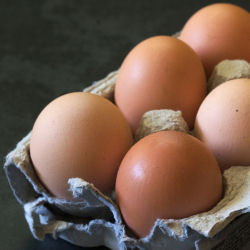 “I can’t wait to show you what I’m sneaking down in my bag,” wrote Laura. “Hopefully you’ll be as delighted as I am!”
“I can’t wait to show you what I’m sneaking down in my bag,” wrote Laura. “Hopefully you’ll be as delighted as I am!”
I knew we would be thrilled with whatever she brought us, and I suspected she’d be stocking our pantry with a fun assortment of jars — she’s an accomplished canner. But what actually landed on our kitchen counter was a jaw-dropping surprise.
Sure, there was a pint of (homegrown) dilly beans, and a pot of (homemade) strawberry jam. But there was also a shrink-wrapped frozen broiler chicken from the farm… and — wait for it — a dozen fresh eggs from the hennery itself … which Laura had brought down in her checked bags! (Eggs, says the TSA, contain more than 3oz of liquid in each “container”. And in any case, a dozen would definitely not fit in a quart-sized Ziploc bag.)
I wish I had thought to take a photo of Laura’s ingenious packaging: two half-dozen cardboard containers inside a perfectly sized plastic food-storage container, all wrapped in packing tape. And miraculously, every last egg made it here intact, with not a single crack.
This, my friends, is the way to get invited back for a return visit!
The three of us ate six of the eggs poached with a big batch of Cameron’s hash on Sunday morning. The yolks were almost fluorescent orange, and the whites held together like magic. (I forgot to take photos — d’oh!) There was Acme toast, too, with a generous slathering of Spring Hill butter and Laura’s no-pectin preserves — not too sweet, soft and fresh-tasting.
We toyed briefly with trying out a new recipe to share here on the blog, but decided that this bird needed little more than a good roasting and some simple accompaniments — we didn’t want to bury the flavor with complicated preparations. The chicken sat salted in the fridge all day, its skin drying out in preparation for a turn on the rotisserie tonight. After 90 minutes on the spit, it emerged golden and crispy-skinned, with juicy white meat and fabulous flavor: Truly the best bird we’ve eaten since the Hoffmans left the market.
SheHe’s a big bird, by farmers market standards — nearly 4 pounds — and we’re looking forward to making chicken pot-pie later in the week with the leftovers. And of course the bones and cartilage will be saved for our next batch of stock. Most guests leave little more than a pile of sheets in the laundry room; a fridge full of home-grown food is sure a welcome change!
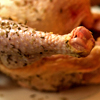




cooking, other blogs, travel
6 Comments »




Posted by Anita on 06.30.08 8:23 AM
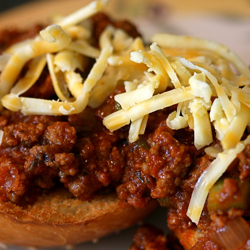 One day last week, the temperature hit a high of 87° — the kind of heat-wave that sends San Franciscans screaming from our un-air-conditioned homes straight to the nearest mall or cinema. Just two days later, the overnight low was 49°; close the windows, crank up the furnace.
One day last week, the temperature hit a high of 87° — the kind of heat-wave that sends San Franciscans screaming from our un-air-conditioned homes straight to the nearest mall or cinema. Just two days later, the overnight low was 49°; close the windows, crank up the furnace.
Combine the wacky weather with the unsettling haze from dozens of wildfires, and you’ve got a recipe for doldrums. We cooked at home 4 nights last week, but it felt like work every time. The meal we’d planned as our One Local Summer supper — glazed lamb spareribs — turned out odd and ugly, completely unworthy of photographs, much less a post.
Luckily, we had an ace in the hole planned for mid-week. Our meat CSA has given us a surplus of ground beef. Throw it in a skillet with a hunk of Fatted Calf chorizo, a couple of the season’s first peppers from Happy Quail, a jar of homemade tomato sauce, and some local onions and garlic: Voilá, instant Sloppy Joes. Paired with a side of bacon-lashed coleslaw, we had ourselves a perfectly fabulous — and 100%-local — quick summer meal. Not glamorous, but definitely delicious.
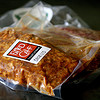



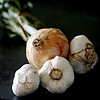
San Francisco Sloppy Joes
1 pound Mexican-style chorizo
1 pound lean ground beef
1 onion, diced
3 cloves garlic, minced
2 whole Anaheim chiles, fresh or canned (or other mild green chiles)
2 cups tomato sauce
1 T ground red chile, or more to taste
salt and pepper
hamburger buns
shredded cheddar cheese and diced raw onion for garnish, if desired
 If using fresh chiles, roast over an open flame or under the broiler, turning to cook all sides until black and blistered. Place charred chiles in a paper bag and roll the top tightly to steam; set aside. If using canned chiles, drain and rinse two large whole chiles and set aside.
If using fresh chiles, roast over an open flame or under the broiler, turning to cook all sides until black and blistered. Place charred chiles in a paper bag and roll the top tightly to steam; set aside. If using canned chiles, drain and rinse two large whole chiles and set aside.
Saute the chorizo in a large skillet over medium heat until browned. Remove the meat from the pan to a large bowl with a slotted spoon, leaving the rendered fat in the skillet. Saute the beef in the chorizo fat, breaking up large chunks. When mostly cooked, add the onion and garlic and cook a minute or two until translucent. Return the beef to the pan, and add the tomato sauce and red chile. Reduce heat to medium-low and simmer.
If using fresh chiles, peel the charred skins off the steamed chiles; do not rinse. Cut the chiles (canned or roasted) into 1/2-inch pieces, and stir into the simmering meat mixture. Cook, stirring occasionally, until sauce is reduced to a spoonable thickness.
Serve over toasted hamburger buns, garnished with shredded cheese and/or raw onions.
cooking, locavore, meat, One Local Summer
17 Comments »




Posted by Anita on 06.30.08 6:52 AM
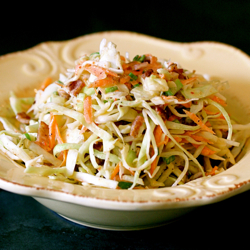 A couple years ago, I decided my cookbook addiction had gotten out of hand, so I put myself on a strict “diet”: No new cookbooks unless I’d tried them out first and fallen in love. If I checked out a book from the library and it sat on the counter for 3 weeks without piquing my curiosity, back it went… without being added to the permanent collection.
A couple years ago, I decided my cookbook addiction had gotten out of hand, so I put myself on a strict “diet”: No new cookbooks unless I’d tried them out first and fallen in love. If I checked out a book from the library and it sat on the counter for 3 weeks without piquing my curiosity, back it went… without being added to the permanent collection.
The new process works remarkably well: I think we’ve added maybe six cookbooks to our stacks in the last three years — when I used to order half a dozen at once without even blinking — and all of them are in heavy rotation on the main cookbook shelf, not languishing away unloved.
Sometimes it’s hard to get my hands on a book for a test-drive; I must’ve waited 8 months on the reserve list for a copy of From My Home to Yours. (And no, much as I thought I had to have it, it didn’t make the cut. I’m just not much of a baker anymore.) Sometimes I have to borrow books from far away via interlibrary loan; luckily, I can do it all online, and pick up my loot at the library near my office when the mood strikes.
One book, though, I couldn’t find anywhere. Not only did the San Francisco Public Library system not have a copy of Cooking Outside the Box — a pretty rare thing, even with newer books — but no library in all of California has a circulating copy. Nobody had even blogged it, so I had no idea if it was any good. I decided to suck it up and buy a copy, rationalizing that $16 was pretty safe bet when it came to a cookbook aimed so squarely at my demographic: Easy, seasonal, organic.
Turns out, my hunch was right. The book — written by the founder of Abel & Cole, Britain’s top organic produce-box service — breaks down into four seasons’ worth of inspiration. His precious measurements are a bit loosey-goosey for my taste (How much is a “1/3 of a mug” of bacon?) and the often-vague directions will be confusing if you’re not an adept cook. Although the recipes offer both metric and American measures, you need to be the sort of cook who’s charmed, not frustrated, by British-isms like: “Your neighbour has stuffed surplus courgettes through your letterbox.” (Happily, I am.)
But all in all, every recipe I’ve made from the book has turned out just wonderfully, despite the lack of hand-holding. They’re mostly quite simple preparations, but usually include one perfectly fabulous tweak. Like bacon… in cole slaw. God love that British ingenuity.





Abel & Coleslaw
– adapted from Cooking Outside the Box
1/2 head cabbage, shredded fine
1 carrot, peeled and grated
3 green onions, trimmed and thinly sliced
3 to 4 strips of bacon, fried until crispy and chopped
1/3 cup mayonnaise, preferably homemade
1 tsp cider vinegar
salt and freshly ground pepper
Mix the mayo and vinegar together in a large bowl. Add the vegetables and bacon, and stir well to combine; taste and adjust seasonings as needed. If time permits, chill 30 minutes before serving.
cookbooks, cooking, locavore
2 Comments »




Posted by Anita on 05.22.08 1:07 PM
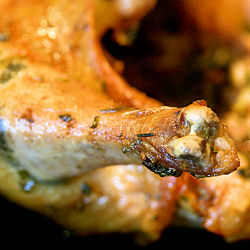 “A whole bird, slaughtered for the nourishment and pleasure of the entire family, is a conspicuous display — if not of serious wealth, then at least of comfort and contentment.
“A whole bird, slaughtered for the nourishment and pleasure of the entire family, is a conspicuous display — if not of serious wealth, then at least of comfort and contentment.
These days, it is also one of the few family meals that demands to be eaten at the table, rather than in front of the television. And, more important perhaps, it is one of the few dishes that is actually capable of getting disparate family members around that table without protest.”
— Hugh Fearnley-Whittingstall,
The River Cottage Meat Book
.
KJ over at A Cracking Good Egg tagged me for the Book Wisdom meme:
1. Pick up the nearest [foodie] book.
2. Open to page 123.
3. Find the fifth sentence.
4. Post the next three sentences.
5. Tag 5 other people* and acknowledge who tagged you.
(* I don’t mind being tagged, but I know other bloggers who feel it’s an imposition. So, let me know in the comments if you want to play along.)
I’m not sure why it’s taken me this long to share The River Cottage Meat Book with you. Even though I’ve had it close at hand since Christmas — it’s always either on the coffee table or my nightstand — I am still wrapping my head around this volume. It’s not that I don’t know that I love it (because I most definitely do). And it’s not that I haven’t cooked out of it enough (because I definitely have). Nor is it because I don’t know if it’s worth your $40 investment (because it definitely is). And it’s not even that I am worried you’ll be unsettled by the beautifully photographed images and descriptions of ethically raised farm animals as they make their way from field to food (because I definitely was).
But despite my unequivocal endorsement — when I win the lottery, I’ll buy a copy for every omnivore I know — I also feel like it might take me years to fully explore this 500+ page treatise of meaty pleasures. It’s not the sort of lighthearted summer cookbook that inspires you to casually toss off a post and then go back to planning next week’s menu. It’s a thinking-man’s cookbook that’s unabashedly carnal and carnivorous, with plenty of thought-provoking commentary woven into its mouthwatering menus.
Don’t get me wrong: It’s no mere meat manifesto. Fearnley-Whittingstall somehow walks an ethical omnivore’s path that’s neither preachy nor overly sentimental. He’s straightforward in that very English sort of way, unromantic and yet so obviously enthralled in what he is doing that you can’t help but wish for your own bucolic farm on the rolling hills of West Dorset (picturesque stone house included). And although the Pollan-esque prose on carnivore ethics is what sets The River Cottage Meat Book apart most directly from most any other cookbook, it’s far from the only reason for owning it.
The book is chock full of useful information about how to purchase meat, even when a supermarket is your only resource. There’s an entire summary chapter devoted to meat thrift — an idea that Fearnley-Whittingstall takes pains to explain has nothing to do with being miserly, despite the obvious frugality. In between, the author shares his vast knowledge on the cuts of meat available from each of the major species, as well as offering up weighty chapters on each sort of cooking: roasting, slow cooking, fast cooking, barbecuing (by which he means grilling), and preserving. From the humblest cottage pie to the most elaborate holiday feast, the recipes are so engaging that you’ll find yourself plotting your next meal around them before you’ve reached the bottom of the page.
Now, you wouldn’t think that a simple roast chicken would tolerate much variation from the usual preparation: Season it, roast it, rest it, carve it. But it’s the little things that set the River Cottage method apart. First, the amount of butter used is quite frankly astounding, but once you taste the end result you’ll be happy you followed directions. The unorthodox technique — opening the body cavity wide; making multiple temperature adjustments; dousing the roasted meat in the buttery drippings — yields a moist bird with shatteringly crunchy skin, despite a relatively brief cooking time. It’s practically the antithesis of the widely lauded Zuni Cafe method, but the end result is equally eye-opening.
—
When I write about a dish I’ve made from a published source, I usually rewrite the recipe in my own words. (Listing a single recipe verbatim is almost certainly within the bounds of fair use, but as a professional writer I’m hypersensitive to issues of authorship. Call me wacky.) But this time, I’m giving you the real McCoy. Not so much because I want you to make this roast chicken — although I suspect it would make a nice change from your usual method, as it was for us — but because I want you to understand the author’s gift of turning even this simple weekend classic into an exercise in clarity, poetry, and deliciousness.
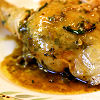


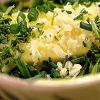

Herb Roast Chicken
– excerpted from The River Cottage Meat Book
1 small but plump roasting chicken weighing about 3 to 4 pounds
7 tablespoons soft butter
generous handfuls of fresh herbs, roughly chopped
1 garlic clove, crushed
1/2 glass of white wine
salt and freshly ground black pepper
Take off any string or elastic trussing from the chicken, place the bird in a roasting pan, and spread out its legs from the body. Enlarge the opening of the cavity with your fingers, so hot air can circulate inside the bird. It will cook quicker like that.
Put the butter in a bowl, throw in the roughly chopped herbs and the garlic, and season well with salt and pepper. Mix together with your fingers, then smear all over the chicken, inside and out. (Note from Anita: I also gently loosen the skin and spread some butter directly onto the meat. Yum.)
Place in the center of a hot oven (400F) and leave for 20 minutes (phase 1). Then baste the chicken [with the drippings], turn the oven down to 350F, pour the wine into the pan (not over the bird), and roast the bird for another 30 to 40 minutes (phase 2), depending on its size. Open the oven door, turn the oven off, and leave the bird for 15 to 20 minutes (phase 3). This is usually enough time to roast a small chicken through without burning the skin (the reason I prefer small chickens for roasting.) For a bigger bird, you will have to make the necessary adjustments, adding a few minutes to each phase. You may also wish to protect the bird’s skin with buttered foil for, say, the first 20 minutes of phase 2. A good test for doneness is to pierce that part of the bird where the thigh joins the breast; the juices released should run clear.
Forget about gravy. Carve the bird in the pan, as coarsely and crudely as you like (no wafer-thin breast slices, please), letting the pieces fall into the buttery pan juices and letting the fresh juices from carving mingle with the rest. Then take the pan to the table and pass it round your family or guests in the pecking order of your choosing, so they can pull out the bits they fancy. Pass it round a second time, to help redress grievances and encourage the further and fairer distribution of juices.
Accompaniments? Roast potatoes would be de trop. A green vegetable would probably go unnoticed. Some good bread to mop up the juices will be appreciated, while a leafy salad, produced only after your guests have demolished the chicken, might assuage a few guilty consciences.
The discover of the roasting pan, a day or so later in a cool larder, is a joy you may not wish to share. Plundered the jellied juices, congealed bits of skin, and crusty meat tatters that cling to the carcass before you quietly make the rest, along with the giblets, into stock.
cookbooks, cooking, meat, other blogs
22 Comments »




Posted by Anita on 05.10.08 5:48 PM
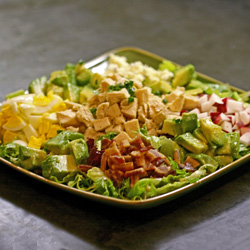 Our usual Saturday breakfast excursions to Primavera — the legendary Mexican-food stall at the Ferry Plaza Farmers Market — are not without a downside. Eating a big plate of chilaquiles or fish tacos or tostadas de ceviche at 9am means we’re rarely hungry for lunch before mid-afternoon.
Our usual Saturday breakfast excursions to Primavera — the legendary Mexican-food stall at the Ferry Plaza Farmers Market — are not without a downside. Eating a big plate of chilaquiles or fish tacos or tostadas de ceviche at 9am means we’re rarely hungry for lunch before mid-afternoon.
Sometimes we’re smart enough to start supper preparations early enough to head off the inevitable 4 o’clock stomach-rumblings. But more often than not, we’re grabbing leftovers or heading to one of our local cheap-eats standbys for a quick bite. Of course, this course of action only prolongs our agony: In our hunger, we eat a full meal.. and then we’re rarely in the mood for for a full-sized dinner. But if we skip our usual evening meal, we often find ourselves hungry again by bedtime.
Clearly, the smart thing to would be to plan for this eventuality, stocking the larder with a few larger-than-snack, smaller-than-meal options for weekend needs. Obviously, we’re not too bright; we know we need to do this, but it’s one of those things that just ain’t glamorous enough to make it to the top of the to-do list.
Last weekend, while rooting through the fridge, I realized that we had all the makings of a really fabulous Cobb salad. (I’m not entirely sure why it took me so long to notice this; it’s not like eggs, bacon, or avocados are any stranger to our kitchen.) Even if we had been lacking one of the main ingredients — tomatoes aren’t always in season, and avocados do go away for a few months, even here in California — this meat-blessed salad makes an adaptable standby, ready to alleviate hunger pangs without stuffing you to the gills.
The best part of making a Cobb at home isn’t that you get to use fabulous ingredients, although that’s undeniably a strong argument in favor of the do-it-yourself approach. No, the very best reason is that you get to toss the damned thing in a proper bowl before plating it. Don’t get me wrong: A prettily composed Cobb is a thing of beauty. But whenever I order one at a restaurant, I end up regretting it. The first few bites are fine, but by the time I’m halfway done, my tastebuds are exhausted by the onslaught of salty, potent flavors. If I push on bravely, I’m left with underdressed, undergarnished lettuce at the bottom of a very sad bowl.
My mom’s a fan of the Cobb salad — and, yes, she’s as neurotic about un-tossed salads as I am. (Maybe that’s where I got it? Hmm…) So whipping up a Cobb salad seems like an especially appropriate Mother’s Day treat.




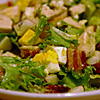
Cobb Salad
— serves 4 as a main course
10-12 cups torn lettuce
– preferably a combination of romaine, red leaf, and something spiky like frisee or escarole
8 strips of bacon, cooked medium-crisp
1 to 2 cups cooked chicken
4 hard-boiled eggs
2 medium avocados
1 cup grape tomatoes, halved (or 1 cup diced radishes when tomatoes aren’t in season)
1 cup crumbled blue cheese
2T chopped fresh chives
—
2T red-wine vinegar
2 cloves garlic, pressed*
1 tsp salt
1/2 tsp black pepper
1/2 tsp Worcestershire sauce
1/2 tsp lemon juice
1/2 cup olive oil
Cut the bacon, chicken, eggs, and avocado into 1/2-inch pieces; set aside.
Whisk together the vinegar, garlic, salt, pepper, Worcestershire, and lemon juice. Slowly drizzle in the oil, whisking until emulsified.
Toss the lettuce with 2/3 of the dressing, and arrange the tossed lettuce on a deep platter or shallow pasta-serving bowl. Toss the chicken cubes with the remaining dressing, and place the chicken in the center of the lettuce, in a tidy pile. Surround the chicken with the remaining ingredients, each one stacked in its own pile. Sprinkle the composed salad with chives.
Show off your beautiful salad to your dining companions, then return to the kitchen to toss all ingredients together. Serve in 4 chilled pasta bowls or other entree-sized shallow bowls.
* I’m not normally in favor of the garlic press, but I think that making salad dressings is one application where it really shines.
cooking, locavore, recipes
7 Comments »




Posted by Anita on 04.07.08 4:22 PM
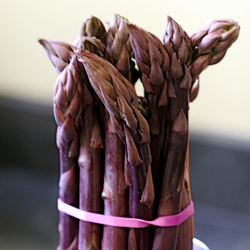 I think it’s safe to say that by any objective measure, Dark Days are well behind us here in San Francisco. Asparagus has been on the farm tables for a month, strawberries made their Ferry Plaza debut this Saturday, and — hooray! — the first pasture-raised chicken of 2008 made its way into our bag (and our bellies) yesterday.
I think it’s safe to say that by any objective measure, Dark Days are well behind us here in San Francisco. Asparagus has been on the farm tables for a month, strawberries made their Ferry Plaza debut this Saturday, and — hooray! — the first pasture-raised chicken of 2008 made its way into our bag (and our bellies) yesterday.
Spring has indeed sprung. And with the dawning of a new season comes the end of the Dark Days Eat Local Challenge.
I know you probably won’t be shocked to hear that April 1 didn’t look a whole lot different in our kitchen than March 31. We’re not going to stop hunting down locally produced foods just because we aren’t documenting every last morsel, after all. Three of the last five dinners we’ve eaten have been made with 100% local ingredients, so I think we’re safely launched down this particular path.
 And for that, I owe huge debt to Laura — for dreaming up Dark Days, for hosting the weekly roundups last fall, and for extending the challenge into 2008 when we all clamored for more. I can only imagine how she manages her own blog and handles her roundups of every Dark Days blogger in the country, all while moving onto her new farm, raising a new brood of chicks, and working a full-time job. (Honestly, I’m exhausted just thinking about it…) I know in my heart that we’d never have dug as deep into our food chain if it hadn’t been for the thrill of the challenge, and knowing we had a built-in audience of Dark Days participants who would share our excitement.
And for that, I owe huge debt to Laura — for dreaming up Dark Days, for hosting the weekly roundups last fall, and for extending the challenge into 2008 when we all clamored for more. I can only imagine how she manages her own blog and handles her roundups of every Dark Days blogger in the country, all while moving onto her new farm, raising a new brood of chicks, and working a full-time job. (Honestly, I’m exhausted just thinking about it…) I know in my heart that we’d never have dug as deep into our food chain if it hadn’t been for the thrill of the challenge, and knowing we had a built-in audience of Dark Days participants who would share our excitement.
Although we’ll stop with our periodic Dark Days wrap-ups, you haven’t heard the last of our locavore ways. In fact, I had high hopes of debuting a new “Bay Area Pantry” page this weekend, showcasing all the products we’ve found that are grown or produced within our foodshed radius. The good news is that it’s 90% ready; the bad news is that time ran out on me, and the final Dark Days roundup must go on, with or without me. I still need to add some links, photos, and section headings, but I’ll let you know when the pantry is fit for public consumption.
In the meantime: Here’s to spring — Let the asparagus-gorging begin!




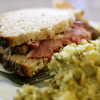
Dark Days Ticker — March 16-31
– Dark Days dinners at home: 9 out of 16
– Locavore dining-out: MÅno, O Izakaya, Marin Sun Farms butcher shop / tour lunch
– New recipes: Reuben sandwiches, feta-stuffed lamb burgers, English muffin bread
– Old faves: Not-Spam and Eggs, choucroute garnie, gumbo, beef stew, Thai beef salad
– Freezer fodder: A16 meatballs, beef stew, Mamster’s carnitas, pasta bolognese
New local items in the pantry:
Middle Eastern Baking lavash (Millbrae)
Hamati pita (San Bruno)
Sconehenge English muffins (Berkeley)
Achadinha brined goat feta (Petaluma)
Fatted Calf sauerkraut, andouille, bockwurst, pastrami (Napa)
Marin Sun Farms slab bacon (Point Reyes)
Alexander Valley Gourmet sauerkraut
cooking, Dark Days challenge, locavore, other blogs
6 Comments »




Posted by Anita on 12.12.07 1:06 PM
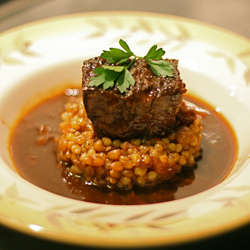 Thanks for sticking with us through last week‘s pity party. I’m slightly embarrassed that I bemoaned the end of avocado season and the near-disappearance of local tomatillos, when any locavore worth her salt would just suck it up, file away those recipes for the winter, and learn to love what’s left.
Thanks for sticking with us through last week‘s pity party. I’m slightly embarrassed that I bemoaned the end of avocado season and the near-disappearance of local tomatillos, when any locavore worth her salt would just suck it up, file away those recipes for the winter, and learn to love what’s left.
I mean, hell, it’s not like we’re in some snowbound location where all we have to eat from October to May is bitter greens and root veggies. And it’s called Dark Days Challenge for a reason — if it were simple, what fun would that be? So, in the spirit of pushing our eating habits into new territory, we ate seven local dinners in a row.
That’s right, kids: Last week, Sunday to Saturday, we ate within our foodshed every single night. Some meals were a stretch, and we fell back on our exemptions and our “90% local” metric with a vengeance. But we were shocked and awed by the number of specialty ingredients that we could source from right in our back yard if we really looked hard enough.
Case in point: For our first meal, potstickers and a long-bean stir-fry, we were happily amazed to find gyoza wrappers made a few miles south of the house (although almost certainly from non-local flour) at our neighborhood Asian grocer. For the filling, we ground Range Bros. pork butt from the Prather boys. All of the various veggies — ginger, scallions, cabbage, and long beans — came straight from the farmers market. We hit our 90% target easily: everything except soy sauce and sesame oil was local.
Another night, we tackled a new recipe for bibimbap. Although it required imported gochujang — a fiery Korean condiment — for the topping, and both soy sauce and sesame oil for the marinade, everything else (meat, rice, veggies, eggs, sprouts, nashi, and even kimchi) hailed from within our 100-mile radius. Surprised we could cook not one but two authentic Asian dinners from 90%-local ingredients? I sure was.
Rounding out the week, there was a pot of chili with a skillet of sage cornbread, a pan of cheesy lasagne, a big batch of pot pie, and Friday night’s traditional linguine Bolognese — with salads on the side and either local wine or SF-brewed beer each night. We were a little stunned to discover that all of these meals fit our challenge ground rules; We even used local flour for the pot pie’s biscuit crust.
Our last local dinner (pictured above) was the most successful of all, in so many ways. We’re helping a friend recipe-test his upcoming cookbook, and one of the recipes he sent us involved a dish we’d probably never have made on our own. Without divulging too many details of this as-yet-unpublished masterpiece, I think I can say that it was totally worth the lunchtime schlep over to the Berkeley farmers market to get Full Belly Farms wheatberries for this dish, rather than opting for one of the substitutions the recipe allowed.
As an added bonus, this was a 100% local meal — perhaps our first? — using Marin Sun Farms beef, homemade chicken stock (from local chicken carcasses), farmers market veggies, Bariani olive oil, homegrown herbs, Anchor Steam beer, and a jar of those Mariquita tomatoes from our home-canned stash. Not a single exemption to be found beyond salt and pepper… Mmm, delicious.
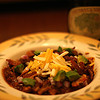
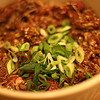

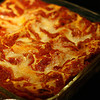
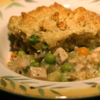
Now, I’d love to share the recipe for that stunning beef dish, but alas I am sworn to secrecy until the book is published.(EDIT: Matthew, the book’s author, kindly corrected my oversight: A very similar recipe was published last spring as part of his Culinate column, Unexplained Bacon.) In the meantime, I can highly recommend our second-favorite meal of the week. This recipe makes enough to serve 8, so we froze half of the filling to use later in the winter. For a quick weeknight meal, all we’ll have to do is whip up a batch of cheddar biscuits, reheat the filling, and wait patiently by the oven.
Chicken Pot Pie with Cheddar Biscuit Crust
– adapted from Gourmet, November 2007
Filling:
1 onion, chopped
2 large carrots, medium (1/2-inch) dice
2 celery ribs, medium dice
1 large parsnip, peeled, cored and cut to medium dice
1 tsp chopped thyme
3 T chicken fat or olive oil
salt & pepper to taste
1/4 cup flour
3-1/2 cups chicken stock
1 cup shelled English peas
4 cups leftover chicken, medium dice
Crust:
2 cups flour (we used 1/2 all-purpose and 1/2 whole wheat)
 2 tsp baking powder
2 tsp baking powder
1 tsp baking soda
1/2 tsp salt
1/2 tsp black pepper
1 cup coarsely grated sharp Cheddar
1/4 cup coarsely grated Dry Jack (or Parmesan)
4T cold unsalted butter, cut into 1/2-inch pieces
2T leaf lard, well chilled and cut into 1/2 pieces
– (or substitute 2T more unsalted butter)
1 cup well-shaken buttermilk
1/4 cup cream, half-and-half, or milk
Sautee the vegetables and thyme in the chicken fat or olive oil over medium-low heat until soft but not browned; add salt & pepper to taste. Sprinkle the sauteed vegetables with flour and cook, stirring well, for 2 minutes or until the flour loses its powdery consistency. Stir in the stock, scraping up any browned bits. Add the peas and bring to a boil, then reduce heat to medium and simmer until thickened, about 5 minutes. Stir in the chicken, and adjust salt and pepper as needed.
The filling can be cooled and refrigerated (or frozen) at this point. Cook refrigerated filling within 24-48 hours; frozen filling will last 3 months if properly stored. If using immediately, lower heat, cover, and keep warm until topping is ready.
Place an oven rack in the middle of the oven, and preheat oven to 400°. If using previously made filling, reheat thoroughly over low heat before proceeding.
To make crust: Sift together all dry ingredients into a large bowl. Add the cheeses and toss to coat with flour mixture. Add butter and cut into the flour using a pastry blender or your fingers until dough resembles a coarse meal. Add the dairy products and stir just until dough comes together; do not overmix. Set aside.
Transfer the filling to two pie pans or a 13×9 casserole. Drop the biscuit dough in 8 large portions on top of the hot filling, leaving space for filling to bubble up, if possible. Bake for 35 minutes, or until biscuits are risen and golden brown. Let stand 5 to 10 minutes before serving.
cooking, locavore, recipes
9 Comments »




Posted by Anita on 12.05.07 12:07 PM
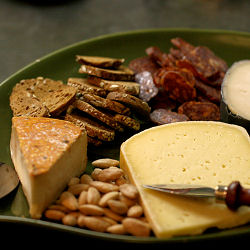 Thank goodness, we’re done with turkey. Blissfully, all of the bits and pieces made their way either into our bellies or the stock pot by early last week.
Thank goodness, we’re done with turkey. Blissfully, all of the bits and pieces made their way either into our bellies or the stock pot by early last week.
On Sunday night, we were so sick of overstuffed plates that we decided to graze. The platter pictured was our family supper: Fra’Mani salumi, Judy’s country crackers, Alfieri’s salted blanched almonds, and three cheeses: Gravenstein Gold, Matos St. George, and Midnight Moon. Every last bit was local, and all of it was delicious.
(For the play-by-play on turkey sandwiches and last week’s other local meals, check out the Flickr set.)
Of course, there’s no getting through Thanksgiving leftovers in our house without the obligatory platter of Enchiladas Suizas. This tangy south-of-the-border specialty is my favorite way to use up excess poultry, no matter the season. But my attempts to keep the dish 90% local highlighted one of the realities of the Dark Days challenge: It’s getting harder to eat as we like as the year wanes.
Unable to find tomatillos at the Ferry Plaza market, I hit up Rainbow Grocery… but theirs hailed from Mexico. I did turn up a few small specimens at the Berkeley farmers market, but they weren’t exactly plentiful. Next year, I’ll follow the lead of the Monkey Wrangler and put up tomatillos when they’re overflowing the market stalls.
But no matter the shopping conundrum, there are few things that make me happier than sitting with my clan around a table full of gorgeous Mexican comfort food. We rounded out the meal with a pan of sopa seca (Mexican rice) and a pot of heirloom beans. We even managed a small bowl of guacamole courtesy of our friend Tea, who gifted us with a trio of the season’s last avocados on her way out of town.
It’s becoming clear that locavore meals are going to require additional creativity in the coming weeks. (Is it cheating to call dried chiles a spice when you’re using them by the bagful to make enchilada sauce? Hmm…) Thankfully, we’ll be able to get our Lundberg rice and our Rancho Gordo tortillas and beans year-round. In the meantime, Rick Bayless assures us that his recipe’s just as good with canned red tomatoes as it is with fresh tomatillos; it might just be the sort of project worth a dip into our pantry stash.


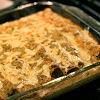


Enchiladas Suizas
– adapted from Mexico One Plate at a Time
3 pounds tomatillos, husks removed, washed to remove sticky residue
– or substitute two 28-oz cans whole tomatoes, drained
2 serrano or jalapeño chiles, stemmed
2T pork fat, chicken fat, or oil
1 medium onion, chopped
2 cups chicken or turkey broth
1/2 cup sour cream, thinned with 2T cream or milk
3 cups shredded meat, such as leftover roast chicken or turkey
2/3 cup shredded melting cheese, such as Jack
12 corn tortillas
For garnish: sliced purple onions, cilantro springs, radish slices
Roast the tomatillos and chiles under the broiler until charred and soft on both sides. Transfer to a blender along with the pan juices and puree until no large pieces remain. (If using canned tomatoes, roast the chiles in a skillet, blend them with the drained tomatoes, and proceed.)
Heat the oven to 350°F.
In a Dutch oven, heat the pork fat over medium heat. Add the onion and saute until golden. Raise the heat a notch and add the puree; cook until thickened to the consistency of porridge, 10 to 15 minutes. Stir in the broth and season to taste with salt. Cover partially and simmer 15 minutes until the sauce is still slightly soupy. Keep warm until ready to use, thinning with more broth or water as needed to keep relatively loose.

Just before using, stir the thinned sour cream into the sauce. In a large bowl, combine the meat with about 1/2 cup of the sauce, or enough to coat it without making too wet. Season to taste.
Lay the tortillas out on two baking sheets, and brush lightly both sides with corn or vegetable oil (or more pork fat). Heat in the oven for about 3 minutes, until tortillas soften enough to roll without breaking. Remove from oven and keep warm, wrapped in a towel.
Spread 1 cup of the sauce on the bottom of a 13 x 9 pan. Roll up a portion of the chicken mixture in each tortilla, then arrange the filled enchiladas in the pan in a single layer. Cover with the remaining sauce, then top with the cheese. Bake until the dish is heated through, about 15 minutes. (Depending on your oven, you may need to cover the top to prevent overbrowning, or turn on the broiler at the end to give the cheese a golden crisp.)
Serve, 2 or 3 to a plate, garnished with onion slices, radishes, and/or cilantro sprigs.
Note: Leftovers are delicious, but because the tortillas lose their shape and consistency, it’s more like a casserole on the second day.
cooking, family, locavore, Mexican, recipes
1 Comment »




Posted by Anita on 11.06.07 4:18 PM
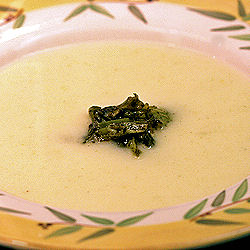 I don’t know about you, but it seems lately like my life is exploding with insanity. It’s not just work, either; it’s home and dogs and life in general. It’s all rush-rush, crazy nonstop chaos… and it’s not even the holidays yet.
I don’t know about you, but it seems lately like my life is exploding with insanity. It’s not just work, either; it’s home and dogs and life in general. It’s all rush-rush, crazy nonstop chaos… and it’s not even the holidays yet.
I knew things had gotten out of hand when I realized we hadn’t seen Paul & Sean — friends we saw nearly every week in the summertime — in more than a month. Worse yet, we hadn’t hosted a dinner party in so long that I couldn’t even remember who had come, or what we’d served. Clearly, something had to give.
Now, the last thing any frenzied soul needs in the midst of a swirling storm of busy-ness is the stress of planning a soirée. So we resolved to keep things simple: A small guest list, a casual menu, and an early start time so as not to keep folks up late. Ah, autumn entertaining… the very best kind, don’t you think?
Contorting our weekly menus into the Dark Days Challenge hasn’t been much of an effort, truth be told. But then, it’s hard to feel too smug when your whole meal plan involves soups, pastas, and meat-potatoes-veg plates with a green salad to start. Weekday dining is pretty fanfare-free at our house, and we like it like that.
But for company, it seemed like a nice touch to try at least one recipe that was just a little more haute than humble. For months, my recipe file has held a strange-sounding starter — Leek & Potato Soup with Melted Leeks in Ash — from rising star chef James Syhabout (of PlumpJack Cafe fame when the article debuted, now chef de cuisine at two-star Manresa… ooh-la-la!). Just as I’d hoped, the soup was special but not too fancy for the casual entree of braised lamb alongside bean-and-rice salad. And then there was that dreamy spice cake, frosted with icing made from local cream cheese and butter… a lovely kickoff to fall, if I do say so myself.
Thanks to the generosity of party guests Cookie and Cranky, we are now in possession of a bag each of whole-wheat flour and cornmeal, both grown by Full Belly Farm in Capay Valley. And — wonder of wonders — I found locally made dried pasta. Although neither organic nor sustainable in any discernible fashion, Eduardo’s Pasta Factory could hardly be more local: They’re just over the neighborhood line in Bayview, pratically visible from our back deck. Better yet, they make a pretty nice assortment of pasta types; this week we bought rotini, linguine, and penne, and there’s a few more shapes awaiting our next shopping trip. All in all, a good week for local carbs.
 New to our pantry this week, sorted by distance:
New to our pantry this week, sorted by distance:
Eduardo’s Pasta Factory dried pasta – San Francisco
Molinari Sicilian-style hot Italian sausage – San Francisco
Mastrelli house-made cheese raviolini – San Francisco
Divinely D’Lish granola – San Francisco (+local farms)
Guittard milk chocolate chips – Burlingame
Amy’s Organic canned split pea soup – Petaluma
Jimtown Store deli artichoke spread / pasta sauce – Healdsburg (Sonoma County)
Alexander Valley Gourmet Manhattan-Style Pickles – Healdsburg
Full Belly Farms certified organic flour and cornmeal – Guinda (Capay Valley)
Sierra Nevada Cheese Gina Marie cream cheese – Willows (near Chico)
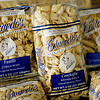
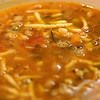
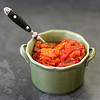
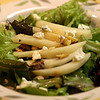
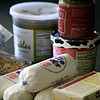
Last week’s Dark Days Challenge meals included:
Beef stroganoff
– Prather Ranch beef chuck, Far West Fungi white mushrooms and dried porcini, Eatwell onions, Clover Organic sour cream, homemade stock
– Eduardo’s Pasta Factory rotini and Dirty Girl haricots verts
Sunday lunch with friends
– Leek-Potato Soup: Little‘s potatoes, Eatwell leeks, homemade veggie broth
– Braised Lamb: Marin Sun Farms leg of lamb, Hedonia preserved lemons, Eatwell onions, Chateau Souverain sauvignon blanc, homegrown thyme, Happy Quail roasted peppers
– Bean & Rice Salad: Eatwell onions, Happy Quail sweet peppers, Rancho Gordo beans, Massa Organics brown rice
– Raita: Hamada cucumber, Chue’s cilantro, Redwood Hill goat yogurt
– Spice cake: Gina Marie cream cheese and Clover Organic butter, Alfieri almond brittle
– Wines: Chateau Souverain syrah, Merryvale Starmont sauvignon blanc
Soup & salad
– Pasta Fazool: Home-canned Mariquita tomatoes, Rancho Gordo heirloom beans, Fatted Calf pancetta, homemade chicken stock
– Pear salad: Little‘s lettuce, Apple Farm pears, Point Reyes blue cheese, Glashoff walnuts, Bariani olive oil, O vinegar
Stacked chile verde enchiladas
– Prather pork, Quail Hollow chiles and tomatillos, Eatwell onions, homemade stock, Rancho Gordo tortillas and beans, Spring Hill colby-jack cheese
Friday (…is always pasta night)
– Mastrelli ricotta raviolini topped with Hedonia marinara sauce
– Molinari hot Italian sausage, grilled
– Salad: Little’s lettuce, Glashoff walnuts, Three Sisters Serena cheese, Chue’s green onions, Bariani olive oil, O vinegar
– Rosenblum 2005 San Francisco Bay Zinfandel (from Alameda!? Who knew!)
cooking, entertaining, locavore, other blogs
8 Comments »




Posted by Anita on 10.31.07 7:05 AM
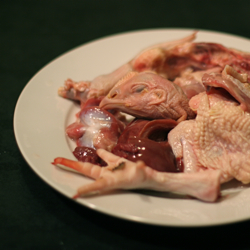 Once upon a time, there was a spoiled teenager named Anita who refused to eat ribs, chicken legs, or any other meat shaped like a body part.
Once upon a time, there was a spoiled teenager named Anita who refused to eat ribs, chicken legs, or any other meat shaped like a body part.
One year, the child’s mother took ill on Thanksgiving morning, with a gaggle of relatives due to descend upon the family home in mere hours. The mere thought of sticking her hand inside (inside!) the body of a turkey made the girl turn green around the edges, but there was nothing to it but to do it: In went the hand, out came the slimey giblet bag. In a word: Gack!
Years later, the girl grew up and got over herself. A culinary school butchery class, which involved parting out cases of chickens and breaking down sides of beef, rid her of the last vestiges of meat squeamishness. The woman became secure with her place on the food chain, an unrepentant carnivore at last.
Flash forward to 2007: In a crisis over the disappearance of Hoffman Farms chickens from the local farmers market, we started buying our weekly roaster from Marin Sun Farms. We’d blithely strolled past their stand for months, seeing the signs for chickens, never venturing in to price them; our Hoffman loyalties were that strong. But the disappearance of their main competition emboldened these farmers, and they began putting their wares on more prominent display: First in bins by the edge of their stall, then moving to a large, copiously iced display — complete with protruding chicken feet — right out in the pathway. (Just the other day, I saw a group of tourists laughing nervously and taking pictures; it’s quite the sight if you’re not used to such things.)
The first afternoon of our patronage, we brought our fine-footed fowl home. The idea of cutting off chicken feet didn’t faze me a bit, I smugly noted. It wouldn’t be any worse than snipping off wingtips, really. I’d seen enough dim sum to grasp the comic possibilities of disembodied chicken feet, and I knew their gelatinous cartilage would add body to our next batch of stock.
I plopped the bagged bird in the sink and turned on the water. Cutting through the rubber band that held the bag shut, I accidentally grazed my arm on a stray claw. (Note to self: Chickens — at least the ones that aren’t factory-gorged on corn — scratch for their supper.) But the sting of avian revenge was no match for the shock I got when I pulled Henny Penny out of the bag: Her frickin’ head was still attached!
Or, well, mostly attached. The neck had been slashed (quite tidily) and her noggin wobbled around on the impossibly long neck in a rather ghastly fashion. Her tiny eyes were mercifully shut, but you could quite clearly make out what her features must have looked like, mere days ago. A tiny comb was clearly visible at the crown of her egg-sized skull. Oh, my…
Snapping out of my guilt-laden reverie, I laughed aloud, amused at how a small, dead hen could rattle me so. Would I have bought her, had I know she came fully equipped? Probably. But coming upon an unexpected beaky face in the bottom of the bag was more than I was expecting. I wondered whether the farmers enjoyed imagining the shock they inflicted on unsuspecting city slickers, but most likely they never gave it a moment’s thought. It’s a chicken, to them. Their livelihood, our supper.
It gets easier, week by week, staring my dinner in the face on a Sunday afternoon. I’ve even come to see the gallows humor in the macabre ritual of removing heads, necks, and feet. I’m not sure I could ever kill a chicken, maybe not even gut a dead one (I’m still not all that happy about innards, truth be told). But if I’m going to be an ethical carnivore, I figure that looking my meat in the eye is the least I can do. And so I do, with silent thanks to the farmer and the chicken.
And then I cackle like a fiend as I throw the dismembered bits in the stockpot. Muuu-huuu-huuu-ahhh!

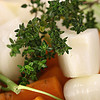



Chicken Stock, Simplified
4 to 5 pounds raw or frozen chicken bits (wings, backs, necks, and feet)
6 quarts filtered water
1 pound mirepoix, very large dice (1 inch or so)
– 1 large onion
– 2 medium carrots
– 2 large celery stalks, trimmed
Bouquet garni
– 2 cloves garlic
– 8 peppercorns
– 3 whole cloves
– 2 fresh thyme sprigs
– 6 parsley stems
…tied with twine in a cheesecloth bundle
In your largest pot, bring water and chicken parts to a simmer; reduce to a lazy bubble and cook for 3 hours. Add the mirepoix and bouquet garni and cook for an additional hour. Strain through cheesecloth or a very fine mesh sieve into a large bowl (or a cool stockpot). Cool to room temperature using an ice-water bath or immersible stock chiller, then chill completely overnight.
The next day, skim the fat and measure stock in 2-cup portions into quart-size freezer bags. Holding the bag upright, squeeze to remove excess air, then seal. Freeze bags flat on a rimmed cookie sheet until completely solid; they can then be stored in your freezer’s pull-out bins, filed like flip-cards along with pasta sauce and other flat-packed liquids. Any odd measures of stock can be frozen in ice-cube trays for quick use in pan sauces and other recipes requiring small amounts of liquid. Store frozen stock for up to 6 months.
cooking, farmers markets, locavore, meat, recipes
16 Comments »




 “I can’t wait to show you what I’m sneaking down in my bag,” wrote Laura. “Hopefully you’ll be as delighted as I am!”
“I can’t wait to show you what I’m sneaking down in my bag,” wrote Laura. “Hopefully you’ll be as delighted as I am!”














 If using fresh chiles, roast over an open flame or under the broiler, turning to cook all sides until black and blistered. Place charred chiles in a paper bag and roll the top tightly to steam; set aside. If using canned chiles, drain and rinse two large whole chiles and set aside.
If using fresh chiles, roast over an open flame or under the broiler, turning to cook all sides until black and blistered. Place charred chiles in a paper bag and roll the top tightly to steam; set aside. If using canned chiles, drain and rinse two large whole chiles and set aside.















































